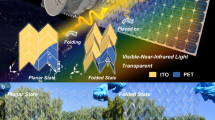Abstract
When a planar dielectric medium has a permittivity profile that is an analytic function in the upper or lower half of the complex position plane x = x′ + ix″ then the real and imaginary parts of its permittivity are related by the spatial Kramers–Kronig relations. We find that such a medium will not reflect radiation incident from one side, whatever the angle of incidence. Using the spatial Kramers–Kronig relations, one can derive a real part of a permittivity profile from some given imaginary part (or vice versa) such that the reflection is guaranteed to be zero. This result is valid for both scalar and vector wave theories and may have relevance for designing materials that efficiently absorb radiation or for the creation of a new type of anti-reflection surface.
This is a preview of subscription content, access via your institution
Access options
Subscribe to this journal
Receive 12 print issues and online access
$209.00 per year
only $17.42 per issue
Buy this article
- Purchase on Springer Link
- Instant access to full article PDF
Prices may be subject to local taxes which are calculated during checkout



Similar content being viewed by others
References
Macleod, H. A. Thin–Film Optical Filters (Institute of Physics Publishing, 2001).
Landau, L. D. & Lifshitz, E. M. Quantum Mechanics (Butterworth-Heinemann, 2003).
Lekner, J. Reflectionless eigenstates of the sech2 potential. Am. J. Phys. 75, 1151–1157 (2007).
Thekkekara, L. V., Achanta, V. G. & Gupta, S. D. Optical reflectionless potentials for broadband, omnidirectional antireflection. Opt. Express 22, 17382–17386 (2014).
Pendry, J. B., Schurig, D. & Smith, D. R. Controlling electromagnetic fields. Science 312, 1780–1782 (2006).
Leonhardt, U. & Philbin, T. G. General relativity in electrical engineering. New J. Phys. 8, 247 (2006).
Valentine, J., Li, J., Zentgraf, T., Bartal, G. & Zhang, X. An optical cloak made of dielectrics. Nature Mater. 8, 568–571 (2009).
Pendry, J. B. Negative refraction makes a perfect lens. Phys. Rev. Lett. 85, 3966–3969 (2000).
Berenger, J-P. A perfectly matched layer for the absorption of electromagnetic waves. J. Comput. Phys. 114, 185–200 (1994).
Teixeira, F. L. & Chew, W. C. Differential forms, metrics, and the reflectionless absorption of electromagnetic waves. J. Electromagn. Waves Appl. 13, 665–686 (1999).
Popa, B-I. & Cummer, S. A. Complex coordinates in transformation optics. Phys. Rev. A 84, 063837 (2011).
Odabasi, H., Teixeira, F. L. & Chew, W. C. Impedance-matched absorbers and optical pseudo black holes. J. Opt. Soc. Am. B 28, 1317–1323 (2011).
Kottos, T. Optical physics: broken symmetry makes light work. Nature Phys. 6, 166–167 (2010).
Makris, K. G., El-Ganainy, R., Christodoulides, D. N. & Musslimani, Z. H. PT-symmetric periodic optical potentials. Int. J. Theor. Phys. 50, 1019–1041 (2011).
Longhi, S. Optical realization of relativistic non-Hermitian quantum mechanics. Phys. Rev. Lett. 105, 013903 (2010).
Lin, Z. et al. Unidirectional invisibility induced by PT-symmetric periodic structures. Phys. Rev. Lett. 106, 213901 (2011).
Regensburger, A. et al. Parity-time synthetic photonic lattices. Nature 488, 167–171 (2012).
Castaldi, G., Savoia, S., Galdi, V., Alù, A. & Engheta, N. PT metamaterials via complex-coordinate transformation optics. Phys. Rev. Lett. 110, 173901 (2013).
Cai, W. & Shalaev, V. Optical Metamaterials (Springer, 2010).
Ye, D. et al. Ultrawideband dispersion control of a metamaterial surface for perfectly-matched-layer-like absorption. Phys. Rev. Lett. 111, 187402 (2013).
Landau, L. D. & Lifshitz, E. M. Electrodynamics of Continuous Media (Butterworth-Heinemann, 2004).
Titchmarsh, E. Introduction to the Theory of Fourier Integrals (Clarendon, 1986).
Lucarini, V., Bassani, F., Peiponen, K-E. & Saarinen, J. J. Dispersion theory and sum rules in linear and nonlinear optics. La Rivista del Nuovo Cimento 26, 1–120 (2003).
Ge, L. & Türeci, H. E. Antisymmetric PT-photonic structures with balanced positive- and negative-index materials. Phys. Rev. A 88, 053810 (2013).
Feng, L. et al. Experimental demonstration of a unidirectional reflectionless parity-time metamaterial at optical frequencies. Nature Mater. 12, 108–113 (2012).
Wu, J-H., Artoni, M. & La Rocca, G. C. Non-Hermitian degeneracies and unidirectional reflectionless atomic lattices. Phys. Rev. Lett. 113, 123004 (2014).
Landau, L. D. & Lifshitz, E. M. Statistical Physics (Part 1) (Butterworth–Heinemann, 2003).
Lekner, J. Theory of Reflection (Martinus Nijhoff, 1987).
Kay, I. & Moses, H. E. Reflectionless transmission through dielectrics and scattering potentials. J. Appl. Phys. 27, 1503–1508 (1956).
Acknowledgements
S.A.R.H. acknowledges financial support from the EPSRC under programme grant EP/I034548/1 and thanks Scuola Normale Superiore (Pisa) for its hospitality. The authors thank J.B. Pendry, T.G. Philbin, A. Di Falco, J.R. Sambles, E. Hendry, I.R. Hooper, A.P. Hibbins, J.-H. Wu, V. Agranovich and V. Lucarini for discussions. In particular, J.B. Pendry and J.R. Sambles are both thanked for separately pointing out the limit of grazing incidence. The authors thank the anonymous referees for their comments, which have much improved the manuscript.
Author information
Authors and Affiliations
Contributions
S.A.R.H. devised the theory, performed the simulations and wrote the manuscript. M.A. and G.C.L.R. worked on the theory and co-wrote the manuscript.
Corresponding author
Ethics declarations
Competing interests
The authors declare no competing financial interests.
Supplementary information
Supplementary information
Supplementary information (PDF 9215 kb)
Rights and permissions
About this article
Cite this article
Horsley, S., Artoni, M. & La Rocca, G. Spatial Kramers–Kronig relations and the reflection of waves. Nature Photon 9, 436–439 (2015). https://doi.org/10.1038/nphoton.2015.106
Received:
Accepted:
Published:
Issue Date:
DOI: https://doi.org/10.1038/nphoton.2015.106
This article is cited by
-
Non-Hermitian control between absorption and transparency in perfect zero-reflection magnonics
Nature Communications (2023)
-
Structural, elastic, electronic, and optical properties of NaAlSi3O8 and Al4[Si4O10](OH)8 from first-principles calculations
Journal of Molecular Modeling (2023)
-
Anti-reflection structure for perfect transmission through complex media
Nature (2022)
-
High-performance Mach–Zehnder modulator using tailored plasma dispersion effects in an ITO/graphene-based waveguide
Scientific Reports (2022)
-
Structural and optical properties of GaAs and InAs for doping Sb under the effect of pressure and temperature: DFT and EPM investigations
Optical and Quantum Electronics (2022)



